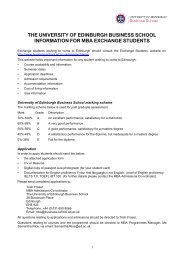killed Saab Automobile? - Business School - University of Edinburgh
killed Saab Automobile? - Business School - University of Edinburgh
killed Saab Automobile? - Business School - University of Edinburgh
Create successful ePaper yourself
Turn your PDF publications into a flip-book with our unique Google optimized e-Paper software.
I/ THE DEATH OF AN AUTOMOTIVE ICON<br />
The final collapse <strong>of</strong> <strong>Saab</strong> <strong>Automobile</strong> in December 2011 marks the unhappy end <strong>of</strong> a long road for this<br />
automotive icon. <strong>Saab</strong> has a long and proud history as a niche auto producer with a strong brand, and<br />
has been a source <strong>of</strong> technical innovation as well as innovative design to the automotive industry. Over<br />
the 62 years it produced cars, it made 4.5 million vehicles, most at its Trollhättan headquarters.<br />
However, contrary to the other vehicle manufacturers in its segment such as Audi, Mercedes-Benz and<br />
BMW, <strong>Saab</strong> failed to grow by <strong>of</strong>fering a wide spectrum <strong>of</strong> models. As a result, production volumes<br />
remained stagnant at around 125,000 units a year. This left <strong>Saab</strong> dependent on its corporate parent<br />
GM (1990-2010) for engineering, for parts and for new product development, which weakened the<br />
appeal <strong>of</strong> the brand. <strong>Saab</strong> was left vulnerable when the global financial crisis hit in 2008. Production<br />
volumes fell from 90,281 units in 2008 to 20,791 in 2009, and never recovered amidst concerns about<br />
the future <strong>of</strong> the company. Production was halted in April 2011 due to parts shortages, and never<br />
resumed until the firm finally was declared bankrupt in December 2011.<br />
There will be many opinions on the causes <strong>of</strong> <strong>Saab</strong>'s failure: manufacturers will point towards<br />
insufficient government support during the crisis; workers will point to poor management by GM; and<br />
the general public will reminisce about how Swedish manufacturing is a faint shadow <strong>of</strong> its past glory.<br />
Yet what facts stand beneath this rhetoric? What are the causes? Was the failure preventable? Why<br />
could even mighty GM not make <strong>Saab</strong> work? Could the Chinese investment have saved <strong>Saab</strong>, if only<br />
GM had agreed to the rescue plan? And should the government have stepped in? Was <strong>Saab</strong> ultimately<br />
too quirky for its own sake?<br />
In this report we provide analysis <strong>of</strong> the underlying reasons for <strong>Saab</strong>'s failure, and set these in the<br />
context <strong>of</strong> the contemporary global automotive industry.<br />
II/ A BRIEF HISTORY OF SAAB<br />
Formation<br />
<strong>Saab</strong> (Svenska Aeroplan Aktie Bolag) was started in 1937 to produce military aircraft. Its formation was<br />
the consequence <strong>of</strong> a government initiative, a response to the increasing likelihood <strong>of</strong> war in Europe.<br />
The company was started with private capital and built a new factory to the north <strong>of</strong> Trollhättan, where<br />
<strong>Saab</strong> cars continued to be built up to the company’s demise in 2011.<br />
The company initially built a version <strong>of</strong> the German Junkers Ju-86 medium bomber under licence,<br />
adding a light fighter-bomber (the American Northrop B5) soon afterwards. Production <strong>of</strong> various other<br />
aircraft followed.<br />
As the Second World War drew to a close, it was clear that there would be a significant reduction in<br />
demand for military production and that other means were necessary to keep the <strong>Saab</strong> workforce<br />
employed. A number <strong>of</strong> alternative avenues were suggested, including spinning reels and prefabricated<br />
sheet steel warehouses, but two were selected for further development – civil aviation and car<br />
manufacture i .<br />
4













